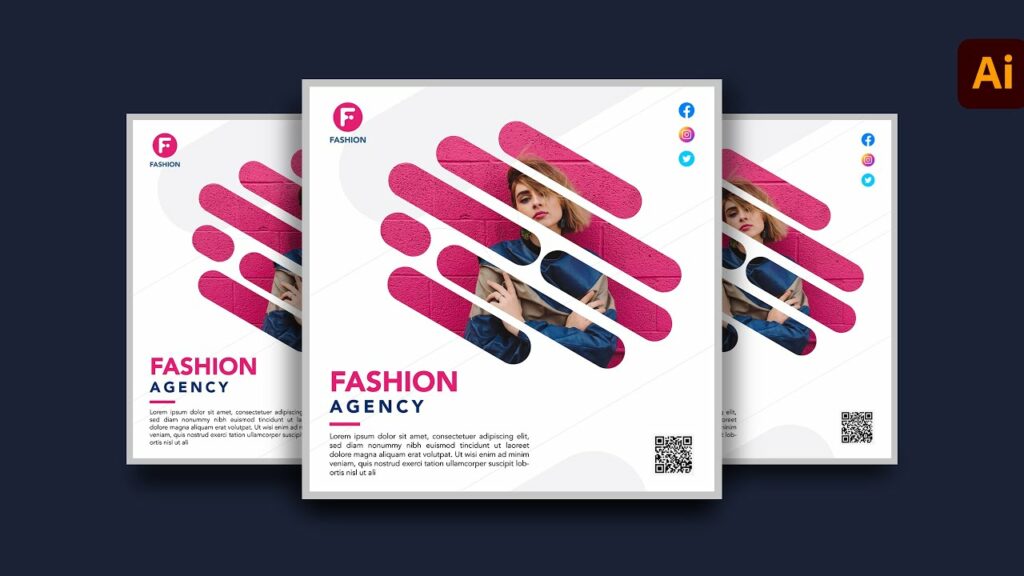Mastering Vector Graphics for Social Media: A Comprehensive Guide to Creating Engaging Posts in Adobe Illustrator

Introduction: Social media has become an indispensable platform for communication, connection, and engagement in the digital age. To stand out in the crowded social media landscape, businesses, influencers, and content creators leverage captivating visuals to capture attention and drive engagement. Adobe Illustrator, with its robust vector-based tools and versatile features, empowers designers to create stunning graphics that resonate with audiences across various social media platforms. In this comprehensive guide, we’ll explore the step-by-step process of making vector graphics for social media posts in Adobe Illustrator, covering everything from conceptualization to final implementation.
Section 1: Understanding the Power of Vector Graphics in Social Media 1.1 The Visual Nature of Social Media: Explore the visual-centric nature of social media platforms, where compelling graphics play a pivotal role in attracting attention and conveying messages effectively. 1.2 Benefits of Vector Graphics: Examine the advantages of using vector graphics for social media posts, including scalability, crispness, and versatility across different screen sizes and resolutions. 1.3 Impact on Engagement and Branding: Discuss how well-designed vector graphics can drive engagement, increase brand visibility, and foster brand loyalty among social media followers.
Section 2: Planning Your Social Media Graphics 2.1 Defining Objectives: Determine the goals and objectives of your social media graphics, whether to promote products/services, share information, entertain, or inspire your audience. 2.2 Audience Analysis: Understand the demographics, preferences, and behaviors of your target audience on social media, tailoring your graphics to resonate with their interests and needs. 2.3 Content Strategy: Develop a content strategy that outlines the types of graphics you’ll create, posting frequency, and thematic consistency to maintain a cohesive brand presence on social media.
Section 3: Getting Started with Adobe Illustrator 3.1 Overview of Adobe Illustrator: Familiarize yourself with the Illustrator workspace, tools, and essential features for creating vector graphics. 3.2 Setting Up Your Document: Create a new document in Illustrator, specifying the dimensions, color mode, and resolution suitable for social media graphics. 3.3 Organizing Artboards: Utilize artboards to organize multiple graphics within a single Illustrator file, facilitating efficient design and batch production workflows.
Section 4: Designing Your Vector Graphics 4.1 Choosing Graphic Type: Determine the type of graphics suitable for your social media posts, whether it’s illustrations, infographics, icons, quotes, or promotional banners. 4.2 Conceptualization and Sketching: Brainstorm ideas and concepts for your graphics, sketching rough outlines and layouts to visualize the composition and message. 4.3 Creating Base Shapes: Use basic shapes, paths, and drawing tools in Illustrator to create the foundational elements of your graphics, focusing on clarity, simplicity, and visual appeal. 4.4 Adding Detail and Visual Interest: Enhance your graphics with details, textures, gradients, and effects to make them visually compelling and engaging for social media audiences.
Section 5: Typography and Text Integration 5.1 Selecting Fonts: Choose appropriate typefaces and font styles for your social media graphics, considering readability, brand consistency, and visual hierarchy. 5.2 Crafting Captivating Copy: Write concise, impactful copy that complements your graphics, conveying the intended message or call-to-action effectively within the limited space of social media posts. 5.3 Text Placement and Formatting: Position text strategically within your graphics, ensuring optimal legibility and visual balance, and experimenting with formatting options such as alignment, spacing, and text effects.
Section 6: Color Palette and Branding 6.1 Choosing Color Scheme: Select a cohesive color palette that reflects your brand identity, evokes the desired mood, and resonates with your target audience on social media. 6.2 Branding Integration: Incorporate brand colors, logos, and visual elements seamlessly into your social media graphics, reinforcing brand recognition and association. 6.3 Ensuring Consistency: Maintain consistency in color usage, typography, and branding elements across all social media graphics, ensuring visual coherence and brand integrity.
Section 7: Finalizing and Exporting Your Graphics 7.1 Reviewing and Proofing: Conduct thorough reviews of your graphics, checking for accuracy, consistency, and alignment with your social media content strategy and branding guidelines. 7.2 Adjustments and Revisions: Make necessary adjustments or revisions based on feedback from stakeholders or testing, refining your graphics until they meet the desired standards and objectives. 7.3 Exporting Files for Social Media Platforms: Prepare your graphics for posting on social media by exporting them in the appropriate file format (e.g., JPEG, PNG) and resolution, ensuring compatibility with different platforms and devices.
Section 8: Application and Posting Strategy 8.1 Posting Schedule: Develop a posting schedule and strategy for sharing your social media graphics, considering factors such as optimal posting times, frequency, and platform-specific best practices. 8.2 Engagement and Interaction: Engage with your audience by responding to comments, questions, and feedback on your social media posts, fostering community interaction and building relationships. 8.3 Performance Tracking and Optimization: Monitor the performance of your social media graphics using analytics tools, tracking metrics such as reach, engagement, and conversion rates, and using insights to optimize future content and strategies.
Conclusion: Creating vector graphics for social media in Adobe Illustrator offers businesses, influencers, and content creators a powerful tool to elevate their online presence, engage audiences, and achieve marketing objectives. By following the comprehensive steps outlined in this guide, you’ll be equipped to create graphics that captivate, inform, and inspire social media followers across various platforms. So, unleash your creativity, embrace the possibilities, and embark on your journey to design vector graphics that make a lasting impact in the digital world.







